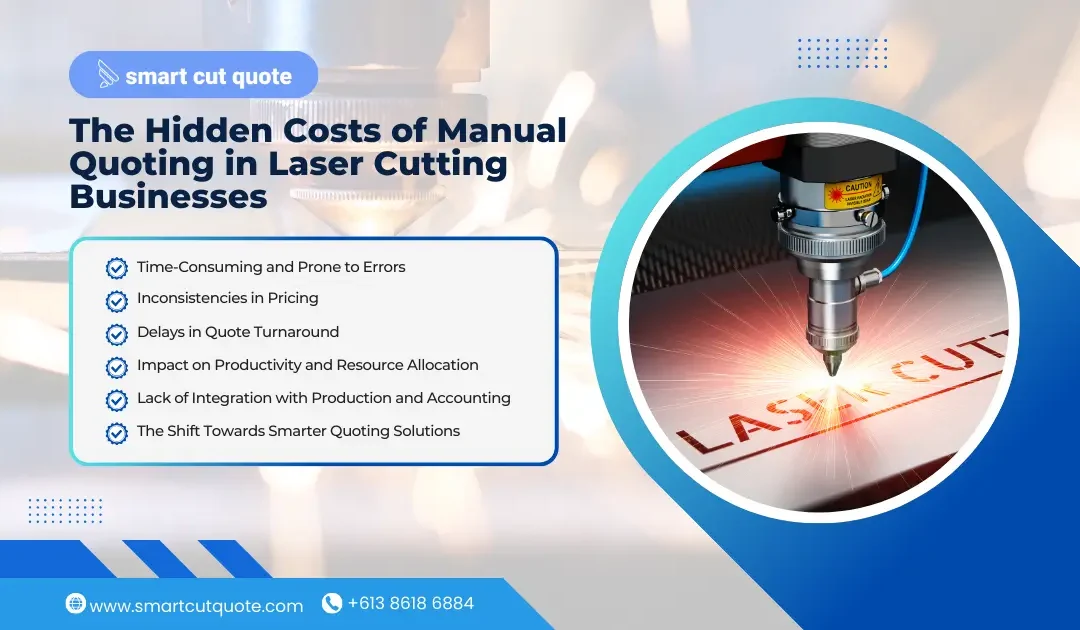The Hidden Costs of Manual Quoting in Laser Cutting Businesses
In the fast-paced world of laser cutting, accurate and timely quoting plays a crucial role in securing business and maintaining profitability. Many job shops and fabrication businesses still rely on manual quoting methods, often underestimating the hidden costs associated with these processes. While it may seem cost-effective at first, manual quoting introduces inefficiencies that impact not only pricing accuracy but also overall business performance.
Time-Consuming and Prone to Errors
Manually generating quotes requires operators to gather material costs, calculate cutting times, factor in machine parameters, and consider overhead expenses—all while ensuring competitive pricing. This process is not only time-consuming but also susceptible to human error. A minor mistake in calculations or missing a key cost component can lead to either overpricing, which may drive customers away, or underpricing, which eats into profit margins.
Inconsistencies in Pricing
One of the biggest challenges with manual quoting is maintaining consistency. Different estimators might approach costing differently, leading to price variations for similar jobs. Inconsistent pricing can confuse customers and weaken trust in a business. Without a structured quoting system, tracking past quotes, adjusting margins based on material fluctuations, and maintaining pricing transparency becomes a difficult task.
Delays in Quote Turnaround
Customers in the laser cutting industry expect prompt responses to their inquiries. A slow quoting process can lead to lost opportunities, as prospects may turn to competitors who can provide a quicker response. Businesses that manually calculate costs often struggle to keep up with demand, particularly during peak times when multiple quote requests need attention simultaneously.
Impact on Productivity and Resource Allocation
Manual quoting diverts skilled employees from higher-value tasks. Instead of focusing on production optimization or customer engagement, valuable time is spent on tedious calculations and data entry. This inefficiency not only increases operational costs but also limits a company’s ability to scale effectively.
Lack of Integration with Production and Accounting
When a manually generated quote is approved, the next challenge is ensuring a smooth transition to production and financial management. Without an automated system, transferring data to manufacturing resource planning (MRP) software, generating process sheets, and updating accounting records becomes another manual task prone to errors and delays. These inefficiencies can result in production bottlenecks, miscommunication, and inaccurate financial reporting.
The Shift Towards Smarter Quoting Solutions
To address these challenges, many laser cutting businesses are moving towards automated quoting solutions that streamline the entire process. By reducing reliance on manual calculations, businesses can ensure accuracy, maintain pricing consistency, and significantly improve turnaround times.
A structured system allows for seamless material and sheet management, real-time cost calculations, and integration with production workflows. With advanced features such as automatic nesting optimization, CAD file clean-up, and detailed cost breakdowns, businesses can quote confidently while reducing waste and inefficiencies. Furthermore, the ability to generate process sheets and CSV files for MRP and accounting systems eliminates manual data transfer, ensuring a smoother transition from quote to production.
In an industry where precision and efficiency matter, relying on manual quoting can hold businesses back. By adopting a smarter approach, laser cutting companies can not only enhance profitability but also deliver a faster, more professional service to their customers.
For more information about Smart cut Quote Software and product inquiries, please contact us at https://nctools.com.au/ or call us on +61 3 8618 6884
Or Visit https://smartcutquote.com/

